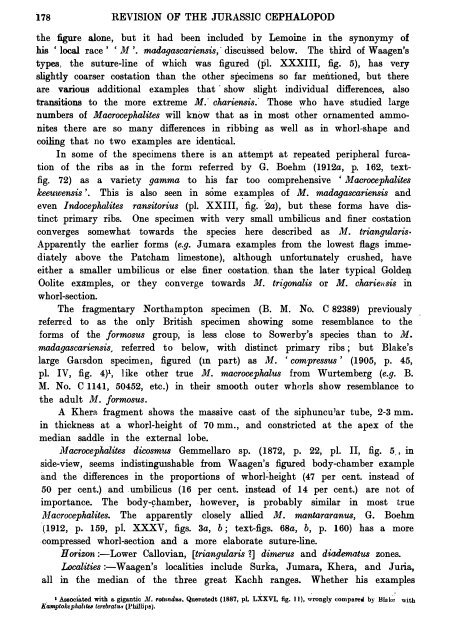ialontolngia ndita,
ialontolngia ndita,
ialontolngia ndita,
Create successful ePaper yourself
Turn your PDF publications into a flip-book with our unique Google optimized e-Paper software.
1.78<br />
REVISION OF THE JURASSIC CEPHALOPOD<br />
the figure alone, but it had been included by Lemoine in the synonymy of<br />
his 'local race ' 'M'. rnadagascariensis," discussed below. The third of Waagen's<br />
types, the suture-line of which was figured (pl. XXXIII, fig. 5), has very<br />
slightly coarser costation than the other specimens so far mentioned, but there<br />
are various additional examples that · show slight individual differences, also<br />
transitions to the more extreme M.· chariensis.' Those ho have studied large<br />
numbers of Macrocephalites will know that as in most other ornamented ammonites<br />
there are so many differences in ribbing as well as in whorl-shape and<br />
coiling that no two examples are identical.<br />
In some of the specimens there is an attempt at repeated peripheral furcation<br />
of the ribs as in the form referred by G. Boehm (1912a, p. 162, textfig.<br />
72) as a variety gamma to his far too comprehensive 'Macrocephalites<br />
keeuwensis '. This is also seen in some examples of M. madagascariensis and<br />
even lndocephalites ransitorius (pl. XXIII, fig. ·2a), but these forms have distinct<br />
primary ribs. One specimen with very small umbilicus and finer costation<br />
converges somewhat towards the species here described as M. triangularis·<br />
Apparently the earlier forms (e.g. Jumara examples from the lowest flags immediately<br />
above the Patcham limestone), although unfortunately crushed, have<br />
either a smaller umbilicus or else finer costation. than the later typical Golde<br />
Oolite examples, or they converge towards M. trigonalis or M. chariensis in<br />
whorl-section.<br />
The fragmentary Northampton specimen (B. M. No. C 82389) previously<br />
referred to as the only British specimen showing some resemblance to the<br />
forms of the formosus group, is less close to Sowerby's species than to M.<br />
madagascariensis, referred to below, with distinct primary ribs ; but Blake's<br />
large Garsdon specimen, figured (m part) as M. 'compressus ' (1905, p. 45,<br />
pl. IV, fig. 4)1, like other true M. macrocephalus from Wurtemberg (e.g. B.<br />
M. No. C 1141, 50452, etc.) in their smooth outer whorls show resemblance to<br />
the adult M. formosus.<br />
A Khera fragment shows the massive cast of the siphuncu1ar tube, 2-3 mm.<br />
in thickness at a whorl-height of 70 mm., and constricted at the apex of the<br />
median saddle in the external lobe.<br />
jlfacrocephalites dicosmus Gemmellaro sp. {1872, p. 22, pl. II, fig. 5. , in<br />
side-view, seems indistingmshable from Waagen' figure body-chamber example<br />
and the differences in the proportions of whorl-height (47 per cent. instead of<br />
50 per cent.) and .umbilicus (16 per cent. instead of 14 per cent.) are not of<br />
importance. The body-9hamber, . however, is probably similar in most true<br />
Jllacrocephalites. The apparently closely allied M. mantararanus, G. Boehm<br />
(1912, p. 159, pi. XXXV, figs. 3a, b; text-figs. 68a, b, p. 160) has a more<br />
compressed whorl-.section and a more elaborate suture-line.<br />
Horizon :-Lower Callovian, [triangularis 1] dimerus and diadematus zones.<br />
Localities :-Waagen's localities include Surka, Jumara, Khera, and Juria,<br />
all in the median of the three great Kachh ranges. Whether his examples<br />
. a Associ&ted with a. gigantic M. rohmd'IUI, Queuatedt (1887, pL LXXVI, fig. ll), rongly compared by Hlak with<br />
Kamptokephalt!ell terebralu,.y (Phillips).
















